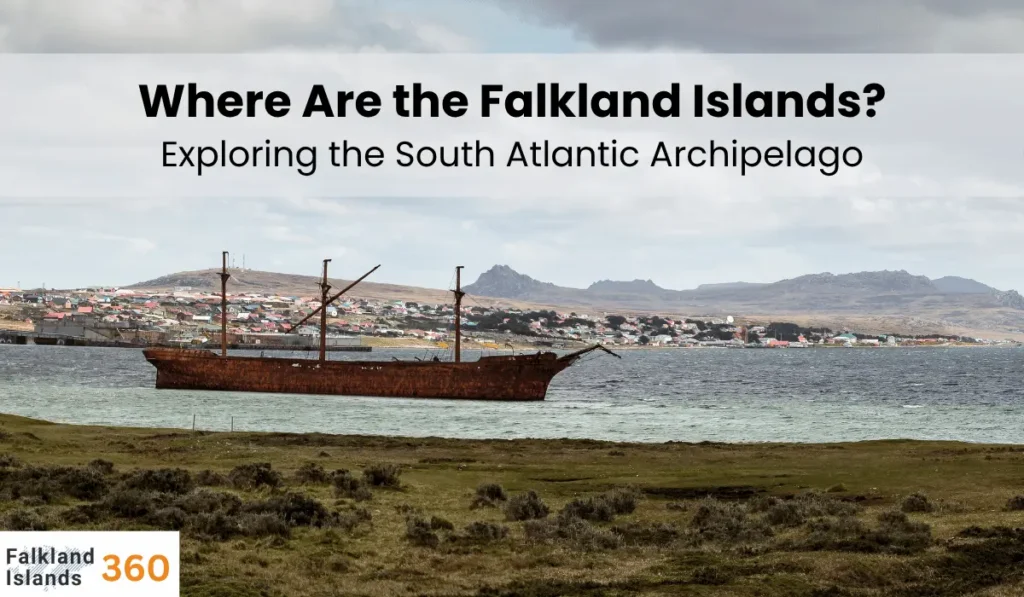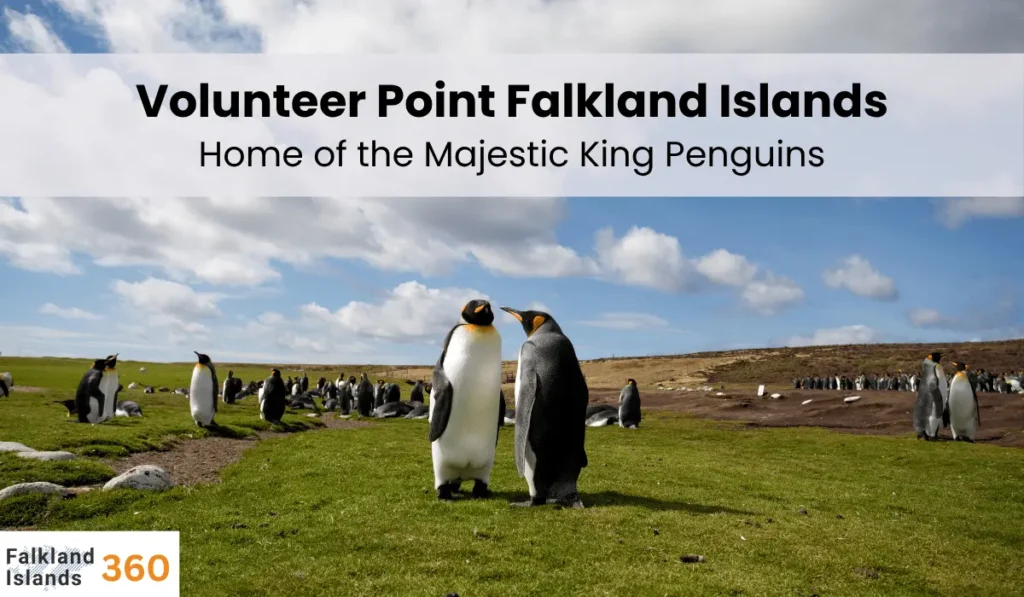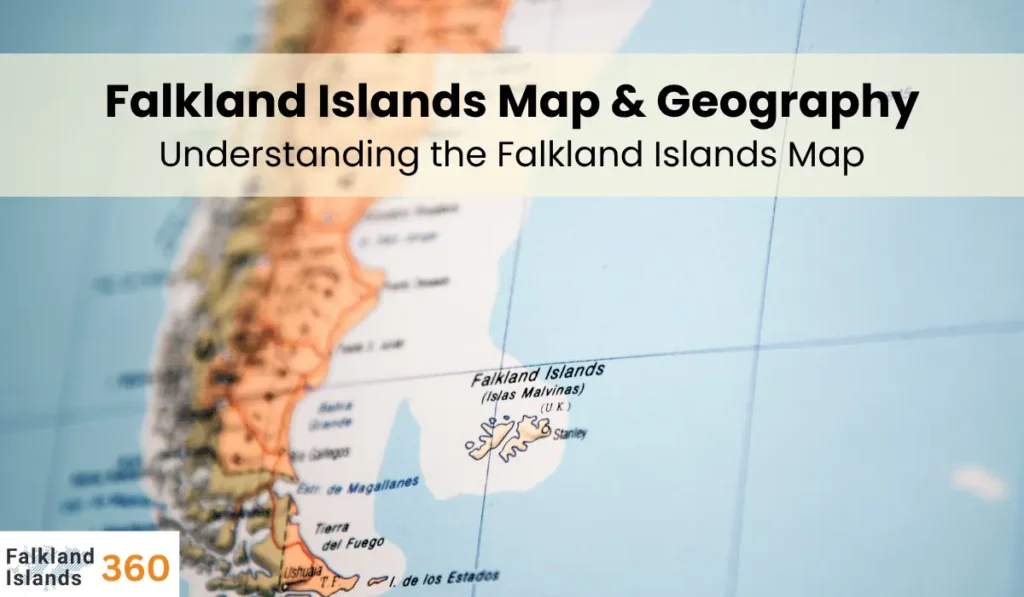The Falkland Islands are a remote archipelago in the South Atlantic Ocean, about 480 km (300 miles) east of the southern tip of South America. This British Overseas Territory (sometimes called Islas Malvinas by Argentina) comprises two large islands (East and West Falkland) and hundreds of smaller ones, totaling about 12,200 km². With a population under 4,000, the islands are sparsely populated – around 80% of residents live in the capital, Stanley.
The Falklands’ location in cool southern latitudes and wind-swept seas gives them a rugged charm that attracts nature lovers and adventurous travellers. A curious reader may ask, “where are the Falkland Islands exactly?” – you can find them on maps between 51°–53°S latitude and 57°–62°W longitude, in the heart of the South Atlantic.
Geography and Political Status of Falkland Islands
The Falklands lie roughly 480 km off the coast of Argentina in the South Atlantic. The two main islands (East Falkland and West Falkland) and about 200 smaller isles form a territory slightly larger than Connecticut. The archipelago is known for its deeply indented coastline with many natural harbours, cool winds, and peat-covered valleys.
Politically, the islands are a self-governing British Overseas Territory; the UK has administered them since 1833. (Argentina maintains a sovereignty claim and uses the name Islas Malvinas, but the islands have their own locally elected government.) The capital, Stanley (sometimes “Port Stanley”), sits on East Falkland and has about 2,000 residents. Even though they’re far from Britain, the Falklands use the Falkland Pound (equal in value to the UK Pound Sterling), drive on the left, and have UK-style 240V electricity plugs.
How to Get to the Falklands
Reaching this distant destination takes a bit of planning. Almost all trips arrive by air or sea. Air travel is the fastest option. Flights land at Mount Pleasant Airport on East Falkland (this is the main international airport). Weekly flights run from Santiago, Chile to Mount Pleasant (often via Punta Arenas) on LATAM.
There are also flights from the UK: two weekly British military-chartered flights run from RAF Brize Norton (via Ascension Island) to Mount Pleasant. (Occasionally there are monthly flights via Argentina.) All visitors flying in take a shuttle bus (20–30 minutes) from Mount Pleasant into Stanley. In summer (November–March), dozens of cruise ships and expedition vessels include the Falklands on their itineraries – a scenic way to arrive if you’re touring Patagonia or Antarctica.
Whether flying or cruising, entry requirements are straightforward: you need a valid passport (for your whole stay) and proof of a return ticket. Land-based travellers must have travel insurance that covers medical evacuation. (No vaccinations or special permits are needed beyond a passport; check if you need a visa before travelling.) There is a small departure tax (about £32) payable when leaving the islands. Once you arrive, you can hire a car (you drive on the left) or use taxis and tours. For reaching other islands, a local inter-island flight service (FIGAS) and a small ferry operate in season.
Wildlife and Natural Highlights in Falkland Islands
The Falkland Islands are famed for wildlife viewing. Hundreds of thousands (indeed millions) of penguins breed here, earning the nickname “the Penguin Islands.” You can easily see four of the five breeding penguin species: Gentoo, Magellanic, Rockhopper and King penguins (Macaroni penguins are rarer). One of the best spots is Volunteer Point, which hosts a large King penguin colony. In spring and summer, fluffy chicks and noisy colonies fill the beaches. Birdwatchers will also find black-browed albatrosses, giant petrels, striated caracaras and endemic species like the flightless Falkland steamer duck and Cobb’s wren.
The surrounding seas teem with marine life: over 20 whale and dolphin species have been spotted, including resident orcas and increasing numbers of sei whales. On land, one may encounter southern elephant seals (the world’s largest seals), fur seals and sea lions lazing on shores. Many wildlife tours run boat trips and guided walks to see these highlights. Even if exploring independently, it’s easy to stumble on wildlife – the animals here show little fear of humans, though you must always keep a respectful distance.
Daily Life and Culture in Falkland Islands
Life on the Falklands feels like a blend of British small-town style with island influences. About 3,000 people call the Falklands home (as of recent estimates). Roughly four in five live in Stanley, a colorful seaside town with Victorian-style buildings, red phone boxes, cozy pubs and cafes. (Fun fact: Stanley is known for a tiny double-decker bus tour and the pastel “End of the World” clock tower.) The economy outside Stanley is mostly sheep farming; over 90% of the land is grass pasture. In “Camp” (the countryside), homes are spread among sheep ranches.
Islands culture is strongly British: people celebrate Queen’s Birthday and Falklands Day, enjoy afternoon tea or the local “smoko” coffee break, and diets feature lamb, seafood (fish & chips and lobster are popular) and hearty full breakfasts. Almost everyone speaks English (it’s the official language), though you may also hear Spanish or Filipino. The currency is the Falkland Pound (tied to UK pound) and both Falkland and UK notes are used interchangeably.
Despite the remote setting, Stanley has modern amenities: a supermarket, banks, a hospital and reliable water/electric power. Do keep in mind that broadband internet can be slow and mobile coverage is strong in Stanley but patchy in the camps. However, local shops, art galleries, a museum, and a friendly community make daily life comfortable for visitors and residents alike.
Travel Tips and Weather
The Falklands’ weather is famously changeable. Strong westerly winds prevail year-round. The climate is cold and maritime: average temperatures barely exceed 10°C (50°F) in summer and often drop below freezing in winter. Rain and drizzle are common, and the sun can be unexpectedly strong (the thin atmosphere can give sunburn). Locals joke about “four seasons in one day”. Pack warm layers, a waterproof jacket and sturdy boots.
Summer (December–February) is the warmest and best for wildlife – expect daytime highs of 12–15°C, along with abundant daylight and breeding colonies in full swing. Winter (June–August) is cold (often 0–6°C) and windy, with shorter days; only if you want solitude or are interested in the 1982 war commemorations (14 June Liberation Day) would you typically visit then.
A few practical tips: driving is on the left, and most roads outside Stanley are gravel tracks. Petrol stations and an ATM exist only in Stanley (Ross Road); carry enough cash (Pounds or Euros/USD) when heading into Camp. Most establishments accept card payments, but smaller shops may charge fees. Even though the Falklands are British-linked, don’t expect UK-style speed or mobility; FIGAS flights and ferry services supplement remote travel.
All visitors need a valid passport, and non-UK nationals should check visa requirements beforehand. Travel insurance including emergency evacuation is strongly advised. Finally, enjoy the friendliness – the Falklanders are known for welcoming travellers – while respecting local rules (for example, avoid touching wildlife or littering, to protect the fragile environment).
Conclusion
Whether you’ve long wondered where the Falkland Islands are or are planning an adventure, these windswept islands offer a one-of-a-kind experience. From viewing penguin rookeries under vast southern skies to enjoying a pint at a Stanley pub after a hike in the moors, the Falklands blend wild nature with warm community.
The journey may be long, but the reward is a visit to a place unlike any other. Wherever you come from, you’ll leave with stories of bright beaches, shaggy sheep hills, and the “penguin islands” that lie between continents and culture.
FAQs
Where are the Falkland Islands located?
In the South Atlantic Ocean, about 480 km east of the southern tip of Argentina. The archipelago lies at roughly 51–53°S, 57–62°W.
Are the Falkland Islands part of the UK?
Yes. The Falklands are a self-governing British Overseas Territory; they have their own local government but the UK handles defense and international relations.
How do I get to the Falkland Islands?
Most visitors fly via Mount Pleasant Airport (on East Falkland). Weekly flights come from Santiago, Chile and the UK (RAF flights). Many cruise ships also stop in summer.
What wildlife is on the Falkland Islands?
Penguins (Rockhopper, Magellanic, Gentoo, King, Macaroni), albatrosses, seals, sea lions, whales, and many bird species. Over 60 bird species breed here.
What is the weather like in Falkland Islands?
Cool and windy year-round. Summer (Dec–Feb) is mild (max ~10–15°C) with long daylight; winters (Jun–Aug) are cold (near freezing) and wet. Pack layers!
Do I need a visa or special permit for traveling to Falkland Islands?
British and many European nationals do not need a visa, but check ahead. All visitors need a valid passport and should have travel insurance covering medical evacuation.
What currency is used in Falkland Islands?
The Falkland Islands use the Falkland pound, which is equal in value to the UK pound. Both Falkland and UK notes are accepted interchangeably. US$ and Euro are accepted at some shops.
Is it safe to visit the Falklands?
Yes – Falklands have low crime. Health care is good (hospital in Stanley) but limited; take out travel insurance. Winter seas and weather can be dangerous if unprepare



